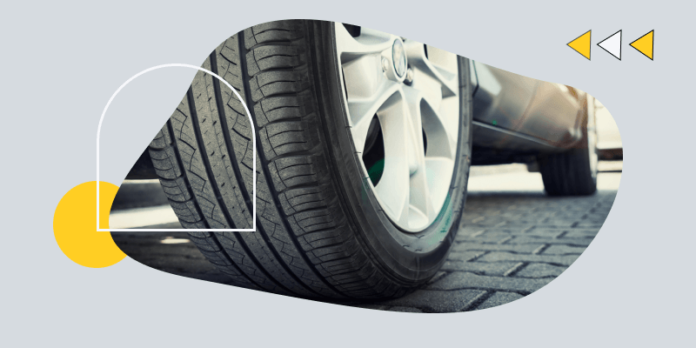Tyres are one of the most crucial automotive parts that keep your vehicle safe and efficient on the road.
Tyres are the sole link between your car and the pavement. They provide steering and directional control, grip for braking and acceleration, and support the weight of your vehicle.
They also work as shock absorbers for vibrations from the road.
When your tyres get damaged or become worn and old, the worn-down tread can lead to compromised road grip. You will also have difficulty braking and stopping effectively.
Old and damaged tyres can also cause blowouts that can leave you stranded. They can also lead to uneven wheel alignment, balance problems, and irregular and premature tyre wear.
Because tyres can mean the difference between a safe and smooth ride and one that is unsafe and stressful, you need to check their quality regularly and invest in a tyre change service when necessary.
Also, check out for mobile car wheel alignment in case you need tyre replacement or wheel alignment done at your doorstep.
How to Know if You Need to Change Your Tyres
Below are the top six signs you need to look out for that indicate you have to replace your tyres immediately:
1. Low tread depth
Tread depth refers to the vertical measurement from the top of the tyre rubber to the bottom of its deepest grooves.
In most countries, the legal safety standard is at least a 1.6-millimetre depth.
To know if your tread depth has already reached this level, try these methods:
Conduct a penny test
If you have a penny, insert the coin with the icon’s head or top part upside down and facing you into the shallowest groove on the tyre. If the head is visible above the tread, it means you only have 1.6 millimetres or less of tread depth left.
This further means that the tyre has reached the end of its life and needs to be replaced immediately.
Use a tread depth gauge.
If you don’t have a penny, using a tread depth gauge is the most reliable way of checking the tyre tread depth.
You can buy a tread depth gauge at an auto parts store and in online shops.
To use this device, simply stick the gauge’s probe into the shallowest groove on the tyre. Next, press the shoulders of the probe against the tread, then read the result. If the result reads 1.6 millimetres or less, change the tyres as soon as possible.
Check the tyre tread wear bar indicator.
Tyres also have built-in tread wear indicator bars, which are located at the bottom of the tread grooves in various locations of each tyre.
When these bars become too noticeable, it means the tyre tread depth is already 1.6 millimetres or less and you need to have it replaced.
2. Noticeable bulges and bubbles
Bulges and bubbles in tyres usually appear after a substantial impact with a pothole or a curb. Manufacturer defects can also cause these, but this does not happen frequently.
The bulge is caused by air getting between the inner liner of the tyre and its outer layer, which is usually made of rubber, fabric, or metal. As a result, an air pocket develops in the weakened area.
If the tyre with bulges or bubbles is not replaced immediately, it could rupture and cause a bigger problem for you and your vehicle.
You need to have the tyre changed as soon as possible, even if it does not have any other damage and the tread depth is still acceptable.
3. Unexpected vibrations
If your car starts vibrating unexpectedly and with no reason, have your tyres checked by a mechanic immediately.
These vibrations can be caused by a variety of factors. However, unbalanced or uneven tyres are the most likely culprits.
When a tyre is improperly balanced, it will wear out unevenly. This, in turn, can cause the tread to be lower on one side than the other.
If the wear difference between tyres is noticeable, consider having them replaced straight away.
A misaligned suspension could be another possible reason for unwanted vibration. If this is the cause, you need to have it aligned immediately since it will affect your ability to drive your car straight. It will also cause faster wear and tear on your tyres.
4. Punctures
Nails or stones lodged in a tyre calls for an immediate visit to a mechanic.
Even if the puncture is not causing excessive leaking, ignoring it can lead to bigger problems later on. Water and moisture can leak into the tyre, which can cause the steel parts to rust.
Additionally, lodged items can weaken the punctured area of the tyre and possibly lead to dangerous blowouts, especially if you don’t have it repaired immediately.
Because of these reasons, it is crucial that you check your tyres for punctures regularly. If you see any, replace the affected tyre with a spare before going out, even if you are going to a service centre.
Keep in mind that it is never a safe idea to run on a damaged tyre even if you are only going on a short drive.
If you don’t have a spare tyre, look for an automotive centre that provides mobile tyre replacement services.
Expert mechanics will visit you at your home or preferred location to replace the damaged tyres with new ones from kenda tyres.
5. Cuts or cracks on the sidewalls
Wear and tear and harsh conditions are the common causes of tyre sidewall cracking.
Cracking is caused by the rubber being exposed to strong sunlight, excessive heat, road surfactants, and ozone exposure.
On the other hand, cuts are caused by force or physical pressure, such as hitting a rock or curb or something sharp.
Cuts and cracks on sidewalls can affect the tyre pressure, causing you to have less fuel-efficient drives. As such, have the punctured tyre checked and repaired immediately once you detect it.
6. Tyre age
Lastly, most manufacturers and automotive experts recommend replacing tyres after five or six years of use, with an absolute replacement timeline of ten years, regardless of their condition or tread depth.
If you are not sure when you got your current tyres, you can check their production year on their sidewalls.
The production year is usually denoted by four numbers. However, some manufacturers add other digits and letters to the date.
Regardless of the numbers and letters you see, focus on the last four digits since these indicate which week and year the tyre was manufactured.
Also, have your tyres checked regularly despite the lack of visible damage.
As a car owner, being safe on the road should always be your priority. Start by making sure your tyres are in excellent condition and you will have one less thing to worry about whenever you are out driving your vehicle.








